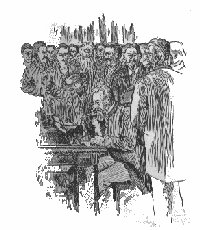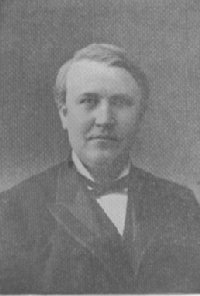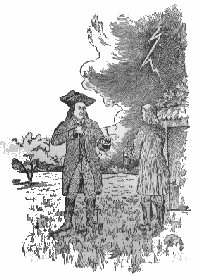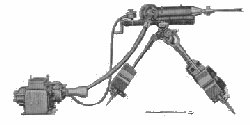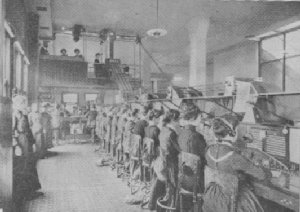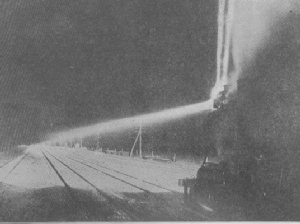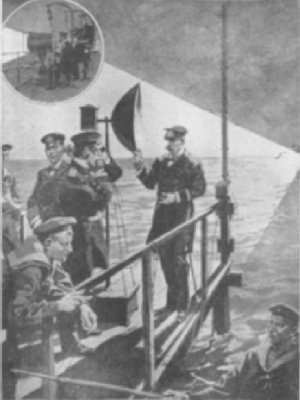The most common of the uses to which electricity is put, aside from that of carrying telephone and telegraph messages, is that of generating power for motion. The trolley car has come to be well nigh universal, while more and more is steam, as a direct motive power, giving way to electricity. To generate electricity in great quantities the dynamo or generator is used. For door bells, most telephones, and several other uses, the galvanic battery serves the purpose. This, in its simplest form, consists of a glass or earthenware vessel, in which vitriol, sal ammoniac and similar chemicals act upon zinc and copper. The dynamo, as well as the static electrical machine, works on the frictional method. The dynamo is a device arranged with a central revolving part which is generally operated by a belt driven by a steam engine. Pressing against the armature, or revolving part, are brushes of metal. The rapid revolution of the armature excites a flow of electricity. This current may be controlled and sent in turn to trolley cars, to electric heating apparatus, to motors for running all sorts of electrical machinery, to electric light plants, or what not. The trolley car is one of the most common agents of the public, which uses electricity. The principle on which they are operated is very simple. Located on the car is a motor, more often two motors, quite similar to the dynamo which generates the electricity in the power house. Just as the revolution of the armature of the dynamo generates electricity, electricity when applied to the armatures of the motors on the car, will cause them to revolve. The electricity comes traveling down the trolley wire and on contact with the trolley on the car, shoots down into the mechanism of the car. On the platforms of the car are the controllers, metal boxes with handles attached to them. These handles control the flow of the fluid into the motor, and allow it to flow at full speed, or direct its course forward or backward. Here the circuit can be broken entirely. Now the motorman wants to start the car. The trolley pole, with its metal wheel in contact with the overhead wire, has brought the current to the controlling box. The motorman switches his handle around a bit, the current flows down to the brushes of the motor, and the armature which is attached to the axle of the car begins to revolve. The electricity having done its work, passes out through a wire attached to the wheels, and flows along the rails into the ground, or back to the negative brush of the generator. As more speed is desired, the motorman throws the controller over a little further, and the car goes merrily on its way. To facilitate the discharge of the electricity after being used in the motor, wires of copper are run from the rails into the ground or return.
The telephone consists of an electromagnet, or, let us say, a coil of copper wire attached to a steel bar charged with magnetism. Close to the bar is a thin sheet of iron or ferrotype. This contrivance is connected with the wire to carry the message and acts with the electrical generating device. Now when sounds are directed against the ferrotype, it causes a break in the current of electricity which is imparted to the wire. At the other end of the wire, a similar device is receiving these impulses by the alternate attraction and cessation of attraction of the plate by the magnet, and the sound is produced. What should we do without the convenience of the modern electric lighting devices? To-day, all that is necessary is to turn a key or switch to flood darkness with light. Two kinds of lights are in common use--the incandescent and the arc light. The former is used principally for offices and residences, while the latter is used more for streets, factories and big halls. The incandescent lamp has reached a nearly perfect stage through the efforts of Edison. It consists of a hollow glass bulb from -which all air has been pumped, and which is then hermetically sealed. Within the globe is a filament of carbon attached to little vises of platinum wire, which in turn connect with the electric wires. The principle which produces the light is that carbon affords high resistance to the current of electricity as it passes over the filament, and thus causes it to become incandescent. The filament is made of the fiber of bamboo carbonized. The length of the wire is regulated by the resistance required. The life of the lamp depends upon the absence of air in the bulb, and in order to exhaust the bulb thoroughly when it is being manufactured, the exhausting process is carried on while the lamp is burning. A good lamp will last about 1,200 hours. When some substance shall be discovered that will not burn away when the electric current passes through it, and yet will give out as strong a light as carbon, then the feeding mechanism of the arc light, with its clutches, magnets, coils and wires, will be dispensed with. The arc lamp, with its intricate machinery, is necessary because no substance has been found so cheap and efficient as carbon.
About 85 per cent of the light of an arc lamp comes from the positive carbon, 10 per cent from the negative carbon, and 5 per cent from the flame between the points. As the carbons are exposed to the air they gradually burn away and the distance between the points increases. In time, this distance becomes too great for the electric current to leap over, and the lights would die out if the carbons were not readjusted. The positive carbon burns away twice as fast as the negative carbon. In fact, a certain amount of the waste from the positive carbon is deposited on the negative point, and in this way the negative carbon becomes slightly pointed, and a crater-like hole I's formed in the end of the opposite carbon. The heat generated by the leaping current is intense. When viewed through a smoky or colored glass, the points seem to be covered with little globular lumps which appear and disappear as though the carbons were melting The heat between the points is great enough to melt platinum, clay, granite and other substances, which can be melted only in the most intense heat, and in electric furnaces, by inclosing large carbon rods in fire brick and striking an electric arc by means of a strong current. As the positive carbon wastes faster than the negative, it is placed above the negative carbon in the arc lamp and the clock work mechanism feeds it down, either continuously or at short intervals, so that the space between the points is always constant, and the lamp burns until the current is switched off or the carbons are consumed entirely. The regulating mechanism differs in the various kinds of arc lamps, but all of them operate about as follows: The current, before it reaches the carbons, passes through two electro-magnets, which control the feeding mechanism, and these two feeding or controlling mechanisms oppose each other. The current which supplies the carbons passes through one of these magnets, while, another current branches off, and, passing through the other magnet joins the former current where it passes out of the lamp, but does not go through the carbons. Ordinarily but a small portion of the current passes through the coil of the second magnet, for it has a higher resistance than the first. When the carbons burn away, the resistance caused by the increased distance between the points becomes greater. If the resistance becomes greater than the resistance in the coil of the second magnet, the electrical current, which always chooses the easiest path, switches itself into the second coil, and thus the total current through the lamp is unchanged. Were it not for this arrangement, a failure on the part of the feeding mechanism of one lamp to keep the carbons at the proper distance apart would give so much current to that lamp that the other lamps in the circuit would be affected materially. The arrangement, however, not only prevents one lamp from affecting the others in the same circuit but by the opposite movements of the mechanisms controlled by the two magnets, the carbon points are readjusted and the arc is brought back to its proper length.
This current, however, will be of short duration, even though the charging current be considerable, because the surface only of the lead plates is affected by the chemical action, the first film of peroxide formed protecting the lead underneath from further oxidation. By repeating the process of charging and discharging, a practical storage cell can be made.
A further improvement came when the lead plates were molded into "grids" or lattice-shaped plates, and red lead was placed in the square openings. The loaded "grids" are placed in diluted sulphuric acid, and the charging current changes the red lead on one plate into spongy masses of metallic lead, and on the other, into a like spongy mass of peroxide of lead. Still another kind of battery is made of a series of horizontal strips of rolled lead a half inch wide, with grooves cut in them. The growth of electrical experiments has brought about many marvelous phenomena. Attempts have been made to make Nature turn out of her course and produce results in many phases of life before the time for maturity. Thus experiments on eggs to make them hatch quickly have resulted in fowls of abnormal size and monstrous shapes. In forcing vegetable growth the result has been more favorable. Especially is this true in maturing seeds by electricity. By using glass cylinders covered with copper disks, through which the current will flow into moistened seeds within the cylinders growth is stimulated. After this treatment the seeds are put in a germinating pan which consists of two plates, one within the other, the inner one being of porous clay. The seeds are placed in filter paper between these, and are kept at a heat of 48 degrees by an electrical device. The result has been very profitable, the growth being 30 per cent quicker. Nikola Tesla, one of the greatest of modern electricians, has succeeded in throwing waves across space and directing the movements of miniature war vessels in a tank of water without the aid of wires. He is working on a method of producing and conducting light without wires.
Experiments in the transmission of speech by means of light beams were first made by Professor Bell some time ago with an apparatus called the "Photophone." The transmitter consisted of a plain mirror so arranged as to reflect the light upon a selenium cell in circuit with an ordinary receiver at the opposite station. The mirror served as a telephone diaphragm, a resonating chamber and mouthpiece being placed at the back. Speaking in the mouthpiece vibrated the mirror, the vibration altering the intensity of the beam of light. The changes in the light beam resulted in the selenium cell (acting with its well-known property of altering its electrical resistance under influence of light) setting up corresponding changes in the receiver circuit, and so producing vibrations in the receiver diaphragm like those communicated to the mirror of the transmiter. Professor Ruhmen, of Berlin, has improved somewhat on Bell's device, but the same principle is retained and the system is successfully used on warships of the German navy. It would seem as though we now have the germ of a means of inter-planetary communication. LATEST MACHINES OF MODERN WARFARE |
